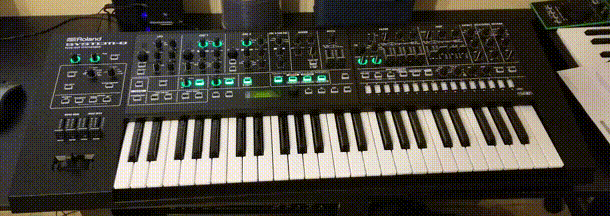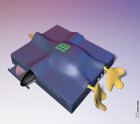Setting Up a Roland System-8 for
Church

Introduction
I created this page in case someone has a Roland System-8, or wants one, and is thinking about using it in church. Setting a System-8 up for church is very easy, and I've made it even easier for the church musician, as follows: buy a System-8, buy an SD card, download my CHURCH.BIN, and load my CHURCH.BIN file.At the end of this document is a list of what patches I have selected for church use.
Step 1: Buy a System-8
This may go without saying, but obviously you're going to need a Roland System-8 for this. I have a few recommendations:If you can afford it, buy your System-8 brand new. I've read on social media of people buying a used System-8 because someone claimed they put the SH-101, or other Plug-Out, on one of the System-8 slots. Ignore this hype, it doesn't matter. You can buy a System-8 used and restore to factory settings to get the native Jupiter-8, Juno-106, and JX-3P Plug-Outs back. And you don't need Roland Cloud to keep these native Plug-Outs on your System-8.
If you buy a used System-8, you might as well update it to the most recent firmware (if applicable) and/or restore to factory, anyways. With the three native Plug-Outs and the native System-8 mode, you're going to have 256 patches and essentially four independent synthesizers: you'll have way more than enough.
Step 2: Buy an SD Card and Get the VST
Then buy an SD card because it's very useful to have in situations where you can't plug the System-8 into a PC to move patches.
I would recommend, however, that you also
get a Roland Cloud subscription or buy the VST/Librarian as a
lifetime key. So far, it seems one can use the VST as a
Librarian without having Roland Cloud, so I'm not saying you must
get Roland Cloud. But at least for the first 30 days of a
trial period, it's useful. You can use this to move
patches around initially.
As for backing up the System-8, each backup costs you about 1MB, so don't worry about how big the SD card is. With 1 GB, you can back up your System-8 1,000 times. What matters is if the SD card works, not how big it is, as it's very difficult to find an SD card brand new that is too small for what you're going to need.
I recommend formatting the SD card as soon
as you first insert it into the System-8 so that it creates the
necessary folders on the SD card. It will create the
folders even if you don't format it, last I checked.
However, some companies include random software and scrapeware
on their SD cards. That's why I recommend just formatting
the SD card.
Step 3: Download My CHURCH files
Then download my church files from the donate page. It's free, I
just politely ask that you donate
if you find it useful. You MUST
download the .bin and the .txt file together and put them in the
BACKUP folder on the SD card. Make sure your System-8 is
off while removing or inserting the SD card into it.
Step 4: Load Patches with VST or Restore to the CHURCH File
If you have a working DAW and the System-8
VST (and the VSTs for the various Plug-Outs), you can simply
plug in your System-8 via USB and send them all (in the patch
menu) to your various Plug-Outs and to the System-8. This
means load the System-8 VST, go in the patch menu and load my
.bin file (the one meant for the VST) and then "Send All" to the
System-8. You may want to back up whatever you want first,
but the factory patches are free from Roland, as well as the
add-on patch sets like the Synthwave and Transient sets.
If you are using the SD card method,
however, then, using the utility menu, restore to the CHURCH
file. Note: if you have not done so, consider backing up
your current System-8 state before restoring to my church
file. I performed a backup the moment I turned on my
System-8 for the first time, just in case. Using this
method will overwrite your settings with mine, but my settings
are conservative.
Note that restoring will remove all your settings and basically turn it into a copy of my System-8 that I use for church. This should include all the Plug-Outs and their patches. But make sure that you currently have the Plug-Outs in the following configuration:
- Plug-Out 1: Jupiter-8
- Plug-Out 2: Juno-106
- Plug-Out 3: JX-3P
This is why I say it's easier just to restore the System-8 to factory before you restore to my church file.
Note that you may need to re-map your performance modes. I will develop a file for restoring your performance modes in the near future.
There is a way to load all the patches from the SD card, one by one, to create your own set of 64. You'd need to menu dive into the UTILITY menu, select restore, select BACKUP or EXPORT folder, select the file, select the patch, and tell it to load that single patch. Then save it to the location you want. While the System-8 VST was temporarily broken by a Windows update, I had to do this. It doesn't take a super long time, but it's going to take longer than using the VST, that's for sure. I think it takes me roughly 1-2 hours (with all the .s8p, .txt, and .bin files on the SD card) to program a set of 64 patches from the various factory sets Roland has provided.
There is also a way to get some of the
patches: go to the Roland Aira website using the Chrome browser,
with your System-8 plugged in. If you find a patch you
like, click to send it to your System-8.
Alternative Setup
One way to set up for church, alternately, is to only download the church files and then to selectively load the patches you find most useful. This will take longer, however, due to having to "menu dive" to load them all one by one.
Another alternate way to do this could be to only load one plug-out with church patches. I can see the Jupiter-8 being all that you might need for church synthesizer use, as it has good string, pad, and lead patches.
What I do is I have a church.bin file on my System-8 SD card. I also have a Synthwave backup. That way I can literally go busking Saturday night and then show up to church with my synthesizer already loaded up.
Patch Listings
This is a quick reduction of the patches I have on my System-8 for church. I have a complete list here, but this is just some highlights for some useful patches included. These are the patches that I end up using the most. I have slightly modified many of the patches so that they are slightly more useful in church, whether it's only how loud they are and how the mod lever is mapped, to reducing attack times, LFO modulations, or even PWM levels. I learned the hard way not to do a lot of heavy modifications because then all the patches sound the same, so your mileage may vary.
For the complete lists, click one of
these: System-8
Jupiter-8
Juno-106
JX-3P
- System-8
- A-1 KY Random Sparks. My favorite patch. I cut
the LFO pitch modulation in half because when paired with a
pad in performance mode, the detune is noticeable and
clashes with the pad.
- A-2 PD Big Pad
- A-3 PD Glass Clouds
- A-4 PD Rich Strings
- A-5 LD Saw Lead
- A-6 BL Hang Dream
- A-7 KY OD Organ
- A-8 For Vocoder: in case, well, you know....
- B-1 KY Legend EP: probably closest to a Rhodes sound
- Jupiter-8
- A-7 1981 Mellow Strings
- C-1 PD JP Soft Pad
- Juno-106
- C-1 PD Juno Soft Pad: my favorite pad (PWM mod rate intensity slightly decreased)
- JX-3P
- A-3 1983 Organ 2 (my music minister's favorite organ sound on the entire System-8)
- D-1 PD Emotive Pad
Performance Modes
Note that the performance modes will need to be re-mapped. I have a list of the factory mappings here. If you want to keep a performance mode, you may need to re-map the two parts. Again, soon I will be providing a file to help you re-map them. But while some of these performance modes are very useful, like "System Organ" and "1981 Orchestra", you may do even better just picking the patches you want and then making your own completely new performance modes. That's basically what I did with mine. I made one "Delete Me" performance mode that is sort of a default Jupiter-8 Strings and Juno-106 Pads patch and then saved that patch over all the performance modes I didn't want to keep. Now when I want to add a performance mode for some song in church, I go there and simply patch edit what's included in that "Delete Me" slot and then save it while renaming it.




